
Common name:Calendula, Pot Marigold
Botanical name:Calendula officinalis
This wonderful flower will grow about 1'-3' tall and has amazing dark green leaves with bright golden-yellow-orange flowers that bloom in winter, spring, and summer. It is an edible flower in organic gardens.
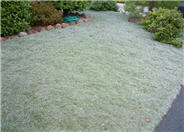
Common name:Dymondia, Rock Ditty
Botanical name:Dymondia margaretae
This foliage is gray/green/silvery; it is a very dense, mat forming ground cover. It tolerates drought, cold, salt spray and poor soils. It's deep rooted and produces small, inconspicuous yellow flowers. Rock Ditty is great for use in between stepping stones or pavers.
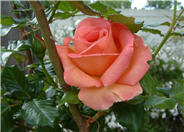
Common name:Hybrid Tea Rose (selections)
Botanical name:Rosa Hybrid Tea varieties
These shrubs and vines are the most loved in the Western USA and are very resilient. They come in a wide variety of sizes and colors and are easy to maintain with proper care. They can be used in a water-conserving garden with careful attention to irrigation practices.
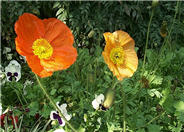
Common name:Iceland Poppy
Botanical name:Papaver nudicaule
This Iceland Poppy produces leaves that are divided with flowers, appearing on stems 1'-2' high. These flowers are cup-shaped to 3" across, and come in colors of yellow, orange, salmon, rose, pink and cream.
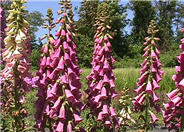
Common name:Foxglove
Botanical name:Digitalis purpurea
This biennial foxglove will reach up to 4' when blooming in the early summer. The large spire of huge, bell-shaped flowers ranges from purple to pink to cream with purple specks. Large, textured leaves form an attractive rosette until bloom time. The plant likes a moist, filtered-sun area similar to the Lobelias and Columbines. Plant it only in shady locations for water conservation consideration.
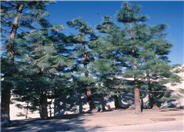
Common name:Canary Island Pine
Botanical name:Pinus canariensis
This graceful, slender-growing pine has a pyramidal form to about 70'. ITs needles are long and drooping inb bundles of 3. The foliage is a blue-green color, maturing to a dark green shade. Pines are highly combustible plants.
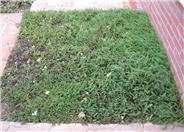
Common name:Woolly Yarrow
Botanical name:Achillea tomentosa
Short stems of flat-topped golden flowers accent the deep green, woolly, fern-like leaves of the mat formed by this plant. It is a fine performer in rock gardens and at the front of herbaceous perennial borders. Yarrow propagate easily from rooted stems or division, which should be performed in the early spring or fall. Following bloom, dead head the plant and divide the clumps when it appears crowded.
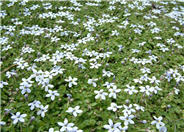
Common name:Blue Star Creeper, Isotoma
Botanical name:Pratia pedunculata
Pratia pedunculata has bright green, nearly stemless, 1/4" leaves. In late spring and summer, these form a backdrop for equally tiny, star-shaped pale blue flowers.

Common name:Giant Bird Of Paradise
Botanical name:Strelitzia nicolai
This clumping evergreen perennial can reach 25' tall fairly quickly, forming a false trunk from the base of the leaves. The leaves are shaped like bananas, reaching 10' long with the widest part reaching 5' . It does best with fertilizer once a month and rich soil. It does not like wet feet so water only when dry. It can be planted in full sun but will do better if it receives afternoon shade. The flowers can reach a size of 10"-12", but plants need to be a few years old before they will flower.
| Designer: Denise Pulley | Brick Road Back Yard Three |
Photographer: GardenSoft |
Soils and Compost:
Physical weed control, including mulching, or hand removal protects the watershed from harmful chemicals.
Water Saving Tip:
Modify your controller each season. In the rainy season turn it off.
Integrated Pest Management:
Attract, or buy beneficial insects such as ladybugs and lacewings to control pest outbreaks in your garden.

